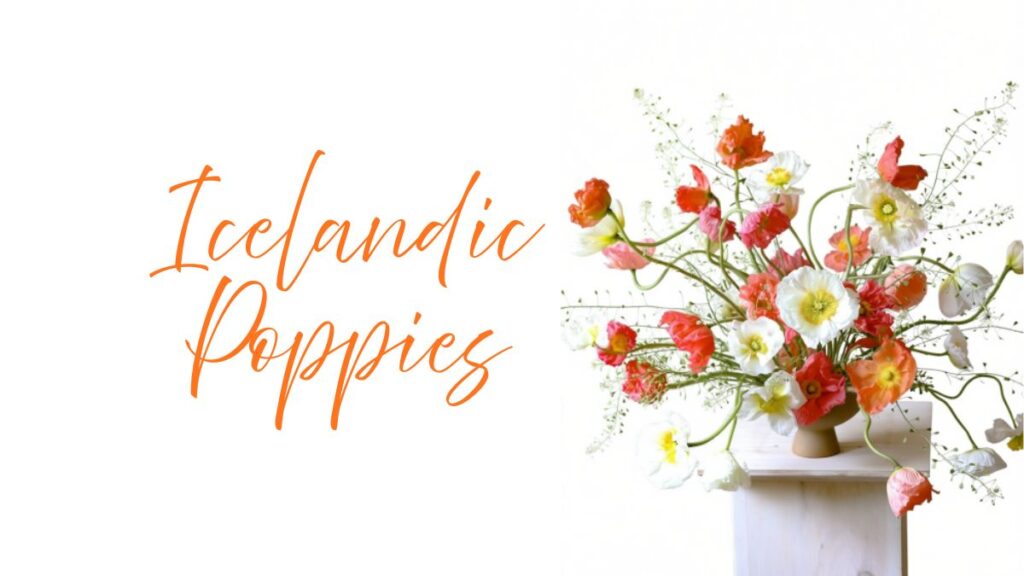Few garden flowers capture the imagination quite like the Icelandic poppy (Papaver nudicaule). With their tissue-thin petals that seem to glow from within, delicate stems that sway in the breeze, and cheerful blooms in soft pastels or vibrant oranges and yellows, Icelandic poppies bring an ethereal charm to any landscape. Despite their name, these captivating flowers are not native to Iceland but are instead found across subarctic and alpine regions of North America, Europe, and Asia. Their misnomer likely stems from early botanical explorers who encountered them in cold, northern climates and associated them with the Nordic island.
In this comprehensive guide, we’ll explore everything you need to know about Icelandic poppies—from their botanical background and cultural significance to practical tips on planting, caring for, and enjoying them in your own garden. Whether you’re a seasoned horticulturist or a novice gardener enchanted by their beauty, understanding how to successfully grow and maintain these short-lived perennials can bring a touch of magic to your outdoor space.
Botanical Background and Characteristics
Scientific Classification and Common Names
Icelandic poppies belong to the species Papaver nudicaule, part of the Papaveraceae family, which includes other well-known poppies like the opium poppy (Papaver somniferum) and the Shirley poppy (Papaver rhoeas). Despite the shared genus, Icelandic poppies contain no narcotic alkaloids and are entirely safe for ornamental use.
Commonly referred to as “Icelandic poppies,” they’re also known as “arctic poppies” or “naked-stemmed poppies,” a nod to their smooth, leafless flowering stalks (“nudicaule” translates to “naked stem” in Latin). These names reflect both their visual traits and their natural habitats—cold, open, and often rocky terrains.
Physical Appearance
Icelandic poppies typically grow 12 to 18 inches tall, though some cultivars may reach up to 24 inches. Their most striking feature is their large, cup-shaped flowers, which can measure 2 to 4 inches across. The petals are incredibly thin—almost translucent—and come in a range of colors including white, cream, pale yellow, salmon, orange, pink, and even bi-colors. The center of each bloom features a prominent cluster of golden stamens, adding contrast and visual interest.
Unlike many poppies that bloom for just a few weeks, Icelandic poppies have a relatively long flowering period, especially in cool climates. In ideal conditions, they can bloom from late spring through early summer, and sometimes even into fall if temperatures remain mild.
The foliage of Icelandic poppies forms a low rosette of deeply lobed, bluish-green leaves close to the ground. These leaves are covered in fine hairs, giving them a slightly fuzzy texture. Importantly, the flowering stems emerge directly from the root crown without leaves, which is why they appear so “naked.”
Lifecycle and Hardiness
Though often treated as annuals or biennials in gardens, Icelandic poppies are technically short-lived perennials. In USDA hardiness zones 2 to 7, they may survive for two or three years, especially if protected from extreme summer heat and humidity. However, in warmer climates (zones 8 and above), they usually behave as annuals due to their intolerance of high temperatures.
These plants thrive in cool, well-drained soils and full sun. They are remarkably cold-hardy and can tolerate light frosts, making them excellent choices for early-season color in northern gardens. Their alpine origins mean they dislike wet feet and hot, humid summers—conditions that often lead to rot or premature decline.
If you want to read more, visit our blog page. We have more topics!
Cultural Significance and Historical Context
Misleading Name, Global Appeal
Despite being called “Icelandic,” these poppies are not native to Iceland. The name likely arose from 18th- or 19th-century plant collectors who labeled cold-climate flora with Nordic associations. In reality, Papaver nudicaule grows naturally from Siberia across northern Canada and into the mountainous regions of the western United States, including Alaska and the Rocky Mountains.
Their presence in such harsh environments has made them symbols of resilience and delicate beauty in adversity. In horticultural circles, they’ve long been admired for their luminous flowers and graceful form. Victorian gardeners prized them for cottage gardens, and modern floral designers favor them for weddings and arrangements due to their romantic, almost otherworldly appearance.
Symbolism and Use in Art
Like other poppies, Icelandic poppies carry symbolic meanings, though less tied to remembrance (a role held by the red corn poppy) and more to dreams, peace, and ephemeral beauty. Their short vase life—often just a few days—reinforces this association with transience, making them poignant choices for artistic expression.
Artists and photographers are drawn to their luminous petals, which seem to capture and diffuse light. In botanical illustration and fine art, Icelandic poppies frequently appear as emblems of spring renewal and fragile elegance.
Growing Icelandic Poppies: Site Selection and Soil Requirements
Ideal Growing Conditions
To successfully grow Icelandic poppies, it’s essential to replicate their native alpine environment as closely as possible. They demand:
- Full sun: At least 6 to 8 hours of direct sunlight daily.
- Excellent drainage: Their roots are highly susceptible to rot in soggy soil.
- Cool temperatures: They perform best in regions with mild summers and cold winters.
- Neutral to slightly alkaline pH: A soil pH between 6.5 and 7.5 is ideal.
Avoid planting them in heavy clay or low-lying areas where water pools. If your garden has poor drainage, consider raised beds or containers filled with a gritty, well-aerated potting mix.
Soil Preparation
Before planting, amend the soil with coarse sand, perlite, or fine gravel to improve drainage. Incorporating a small amount of compost can provide nutrients, but avoid rich, nitrogen-heavy soils, which can encourage leafy growth at the expense of flowers and increase susceptibility to disease.
Icelandic poppies do not like to be transplanted once established, so choose their permanent location carefully. Their taproots are sensitive and easily damaged, making them poor candidates for division or relocation.
Propagation: Seeds vs. Transplants
Growing from Seed
The most reliable way to grow Icelandic poppies is from seed. They germinate best in cool conditions (55–65°F or 13–18°C) and require light to sprout—do not cover the seeds with soil. Simply press them gently onto the surface of moist, well-drained potting mix.
You can start seeds indoors 6 to 8 weeks before the last frost, using individual pots or cell trays to minimize root disturbance. Alternatively, direct-sow them in the garden in early spring as soon as the soil can be worked, or in late summer for fall establishment and spring blooming.
Keep the soil consistently moist (but not wet) during germination, which typically takes 10 to 20 days. Once seedlings emerge, thin them to 6–12 inches apart to allow for good air circulation.
Transplanting Challenges
While nursery-grown Icelandic poppies are sometimes available, they are notoriously difficult to transplant successfully. Their deep taproots resent disturbance, and even slight root damage can cause the plant to go into shock or die. If you must transplant, do so when the seedlings are very young and handle the root ball with extreme care.
For this reason, many experienced gardeners prefer direct sowing or starting seeds in biodegradable pots that can be planted directly into the ground.
Care and Maintenance
Watering Needs
Icelandic poppies prefer consistent moisture but absolutely cannot tolerate waterlogged soil. Water deeply but infrequently, allowing the top inch of soil to dry out between waterings. In hot weather, they may wilt dramatically—even with adequate moisture—due to heat stress, not drought. Avoid overhead watering, which can promote fungal diseases; instead, use drip irrigation or water at the base of the plant.
Fertilization
These plants are light feeders. A single application of balanced, slow-release fertilizer at planting time is usually sufficient. Over-fertilizing, especially with high-nitrogen formulas, can lead to lush foliage but fewer blooms and weaker stems.
Deadheading and Bloom Extension
Deadheading (removing spent flowers) encourages continued blooming and prevents the plant from expending energy on seed production. However, if you’d like to collect seeds for future planting, allow a few flowers to go to seed at the end of the season.
In cooler climates, Icelandic poppies may bloom intermittently throughout the summer. In warmer zones, flowering often ceases once temperatures consistently exceed 75°F (24°C). Providing afternoon shade in hot regions can help extend the bloom period slightly.
Pest and Disease Management
Icelandic poppies are relatively pest-resistant but can be vulnerable to:
- Aphids: These small insects may cluster on new growth. A strong spray of water or insecticidal soap usually controls them.
- Slugs and snails: These pests may chew on young foliage, especially in damp conditions. Use organic baits or copper barriers for protection.
- Root rot: Caused by overwatering or poor drainage. Prevention through proper site selection is key.
- Powdery mildew: Appears as a white, powdery coating on leaves in humid conditions. Ensure good air circulation and avoid overcrowding.
Because of their short lifespan and sensitivity, chemical interventions should be used sparingly. Focus instead on cultural practices that promote plant health.
Landscape Uses and Companion Planting
Garden Design Applications
Icelandic poppies shine in informal, cottage-style gardens, rock gardens, and borders. Their delicate form contrasts beautifully with sturdier perennials like lavender, salvia, or ornamental grasses. Planted in drifts, they create a sea of soft color that sways gently in the wind.
They also work well in cutting gardens, though their short vase life (2–4 days) means they’re best used in arrangements meant to be enjoyed immediately. To extend their longevity in bouquets, sear the stem ends in boiling water for 10 seconds before placing them in cool water—a technique that helps seal the sap and improve water uptake.
Companion Plants
Choose companions that share similar growing requirements: full sun, excellent drainage, and cool roots. Good options include:
- Dianthus (pinks): Offers fragrant, long-blooming flowers in complementary colors.
- Alyssum: A low-growing ground cover that helps retain soil moisture without competing for nutrients.
- Penstemon: Native perennials with upright spikes that provide vertical contrast.
- Sedum or Sempervivum: Succulents that thrive in dry, rocky soils and add textural interest.
Avoid planting Icelandic poppies near aggressive spreaders or heavy feeders that might overshadow or outcompete them.
Popular Cultivars and Varieties
Over the years, plant breeders have developed numerous cultivars of Icelandic poppies with improved vigor, color range, and bloom size. Some standout varieties include:
- ‘Champagne Bubbles’: A mix offering ruffled, semi-double flowers in soft pinks, oranges, and creams.
- ‘Wonderland’ series: Compact plants with large, single blooms ideal for containers.
- ‘Illumination’: Features extra-large, luminous flowers on strong stems—excellent for cutting.
- ‘Oregon Rainbows’: A strain developed for better heat tolerance and extended bloom time.
When selecting seeds or plants, consider your local climate. Some cultivars are bred specifically for cooler regions, while others offer slightly improved performance in milder zones.
Challenges and Common Mistakes
Even experienced gardeners sometimes struggle with Icelandic poppies. Common pitfalls include:
- Overwatering: The #1 cause of failure. These plants prefer to dry out slightly between waterings.
- Transplanting mature plants: Always start from seed or use very young seedlings.
- Planting in shade: They need full sun to bloom profusely.
- Ignoring soil drainage: Amend heavy soils or use raised beds.
- Expecting long-term permanence: Remember, they’re short-lived. Plan for reseeding or annual replanting.
Patience and attention to their specific needs are key. Once you master their preferences, Icelandic poppies can become a reliable and breathtaking feature of your spring garden.
Ecological Role and Wildlife Value
While not a major nectar source for pollinators compared to other flowers, Icelandic poppies do attract bees and small flies with their open, accessible blooms. Their early flowering period provides valuable forage in spring when fewer floral resources are available.
Importantly, they are non-invasive and pose no threat to native ecosystems. In fact, their preference for undisturbed, well-drained soils means they rarely spread aggressively beyond their planting site.
Conclusion: Embracing the Ephemeral Beauty of Icelandic Poppies
Icelandic poppies may be fleeting, but their impact is lasting. Their luminous blooms, delicate stems, and cool-climate charm make them a favorite among gardeners who appreciate subtlety and grace. While they demand specific growing conditions—excellent drainage, full sun, and cool temperatures—their rewards are well worth the effort.
By understanding their needs and respecting their short-lived nature, you can enjoy these enchanting flowers year after year, whether through careful reseeding, strategic companion planting, or simply savoring their brief but brilliant display. In a world of bold and brash garden blooms, Icelandic poppies offer a quiet, poetic reminder of nature’s delicate balance.
Whether you’re tucking them into a rock garden, featuring them in a spring bouquet, or watching bees visit their golden centers on a cool morning, one thing is certain: growing Icelandic poppies is an act of horticultural poetry. And with the right care, your garden can become a canvas for their ethereal beauty.
From their misleading name to their global appeal, Icelandic poppies continue to captivate. Their resilience in harsh climates and vulnerability in our gardens teach us patience and attentiveness. As you plan your next planting season, consider making space for these radiant, short-lived perennials. You may find that their transient beauty leaves a permanent impression.
In every petal, in every breeze-caught stem, Icelandic poppies whisper the quiet joy of gardening with nature—not against it. And in that harmony lies their true magic. So go ahead: sow some seeds, prepare your soil, and welcome the luminous charm of Icelandic poppies into your life.







